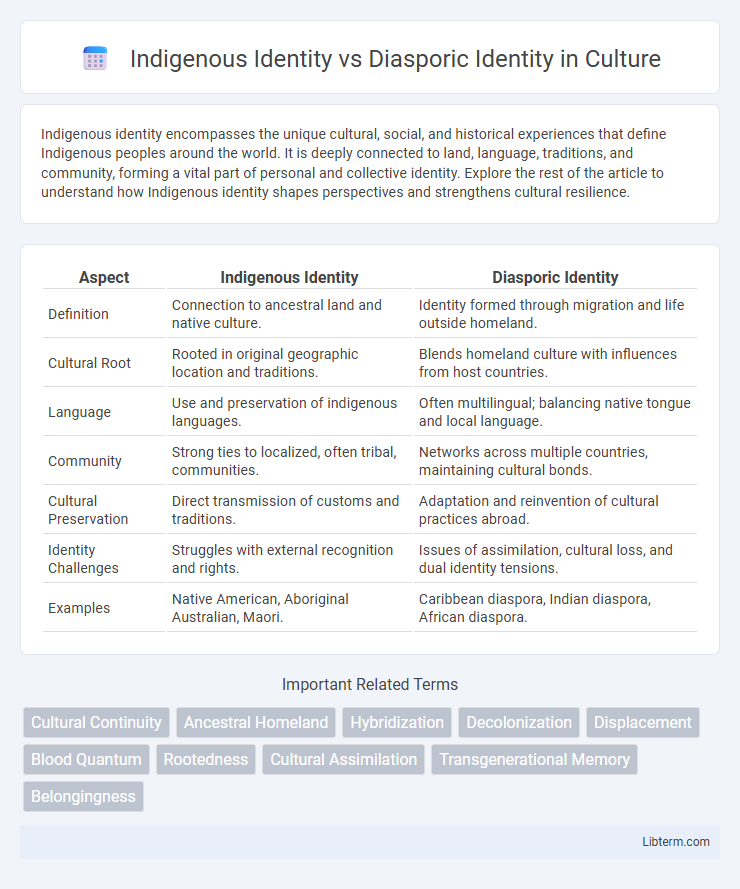Indigenous identity encompasses the unique cultural, social, and historical experiences that define Indigenous peoples around the world. It is deeply connected to land, language, traditions, and community, forming a vital part of personal and collective identity. Explore the rest of the article to understand how Indigenous identity shapes perspectives and strengthens cultural resilience.
Table of Comparison
| Aspect | Indigenous Identity | Diasporic Identity |
|---|---|---|
| Definition | Connection to ancestral land and native culture. | Identity formed through migration and life outside homeland. |
| Cultural Root | Rooted in original geographic location and traditions. | Blends homeland culture with influences from host countries. |
| Language | Use and preservation of indigenous languages. | Often multilingual; balancing native tongue and local language. |
| Community | Strong ties to localized, often tribal, communities. | Networks across multiple countries, maintaining cultural bonds. |
| Cultural Preservation | Direct transmission of customs and traditions. | Adaptation and reinvention of cultural practices abroad. |
| Identity Challenges | Struggles with external recognition and rights. | Issues of assimilation, cultural loss, and dual identity tensions. |
| Examples | Native American, Aboriginal Australian, Maori. | Caribbean diaspora, Indian diaspora, African diaspora. |
Defining Indigenous Identity in Contemporary Contexts
Defining Indigenous identity in contemporary contexts involves recognizing the deep-rooted connection to ancestral lands, languages, and cultural practices that shape the unique social and spiritual frameworks of Indigenous peoples. This identity is sustained through community membership, intergenerational knowledge transmission, and legal recognition under frameworks like the United Nations Declaration on the Rights of Indigenous Peoples (UNDRIP). Contemporary Indigenous identity also navigates the impact of colonial histories and globalization, balancing cultural revitalization with adaptation to modern societal structures.
Understanding Diasporic Identity: Roots and Nuances
Diasporic identity embodies a complex interplay of cultural heritage, memory, and adaptation, shaped by migration and displacement across generations. It involves maintaining connections to ancestral roots while negotiating new social, political, and cultural landscapes in host countries. This dynamic identity reflects hybridity, resilience, and a continuous redefinition of belonging beyond geographic origins.
Historical Contexts Shaping Indigenous Communities
Historical contexts shaping Indigenous communities include colonization, forced displacement, and cultural assimilation policies that disrupted traditional ways of life and social structures. These experiences contribute to distinct Indigenous identities rooted in land, language, and ancestral ties, contrasting with diasporic identities often formed through migration, adaptation, and hybrid cultural influences. Understanding these historical factors is crucial to recognizing the resilience and diversity of Indigenous identities within global diasporas.
The Complexities of Diaspora: Migration and Belonging
Diasporic identity involves navigating the complexities of migration, where individuals experience a continuous negotiation between their ancestral heritage and the cultural contexts of their host countries. This dynamic often results in hybrid identities that challenge fixed notions of belonging, as diasporic communities simultaneously preserve traditions and adapt to new environments. Unlike Indigenous identity, which is primarily rooted in original territorial connections and collective historical experiences, diasporic identity emphasizes fluidity and the redefinition of belonging across transnational spaces.
Language, Land, and the Fabric of Indigenous Identity
Language embodies the essence of Indigenous identity, preserving unique worldviews and cultural knowledge deeply connected to ancestral land. The relationship to land is foundational, grounding Indigenous identity through stewardship, spiritual ties, and historical continuity that diaspora communities strive to maintain despite displacement. The fabric of Indigenous identity weaves language and land together, sustaining community resilience and cultural revival amid challenges posed by migration and globalization.
Cultural Retention and Adaptation in Diasporic Communities
Diasporic communities maintain Indigenous identity through cultural retention by preserving ancestral languages, rituals, and traditional crafts, serving as vital links to their heritage despite geographic displacement. Adaptation occurs as these communities blend Indigenous practices with host country influences, creating hybrid cultural expressions that reinforce identity while facilitating social integration. This dynamic balance between preservation and innovation ensures the survival and evolution of Indigenous identity within diasporic contexts.
Intergenerational Knowledge: Indigenous vs Diasporic Transmission
Intergenerational knowledge in Indigenous identity is deeply rooted in oral traditions, ceremonies, and direct connection to ancestral lands, ensuring cultural continuity and spiritual belonging. Diasporic identity relies more on adaptive transmission methods through storytelling, digital communication, and community gatherings to maintain cultural heritage across dispersed populations. The contrast highlights Indigenous knowledge as place-based and ritual-centric, while diasporic knowledge adapts to displacement with a focus on memory preservation and hybrid cultural practices.
Negotiating Authenticity and Representation
Negotiating authenticity in Indigenous and diasporic identities involves a complex interplay between self-representation and external perceptions shaped by cultural, historical, and political contexts. Indigenous identity often rests on land, community continuity, and ancestral connections, contrasting with diasporic identity, which navigates hybrid cultural expressions and reconstituted traditions across geographic displacements. Representation challenges arise as both groups strive to assert genuine narratives while resisting stereotypes and imposed definitions that undermine their lived experiences and collective agency.
Challenges of Hybridity: Bridging Two Identities
Navigating Indigenous identity alongside diasporic identity often creates challenges of hybridity, as individuals strive to balance cultural heritage with the influences of their diaspora environment. These challenges include negotiating language barriers, maintaining ancestral traditions, and confronting societal expectations that may conflict with one another. The process of bridging these two identities requires constant adaptation and resilience to foster a cohesive sense of self in culturally diverse contexts.
Paths Toward Solidarity and Empowerment
Indigenous identity centers on ancestral lands, cultural continuity, and self-determination, fostering solidarity through shared heritage and collective rights advocacy. Diasporic identity emphasizes displacement experiences, hybrid cultural expressions, and resilience in new environments, creating empowerment via transnational networks and cultural reclamation. Paths toward solidarity and empowerment emerge by bridging these identities through mutual recognition, collaborative activism, and cultural exchange initiatives.
Indigenous Identity Infographic

 libterm.com
libterm.com